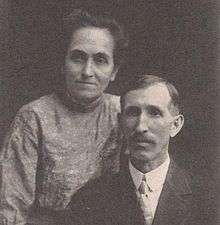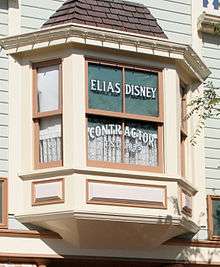Elias Disney
Elias Charles Disney (February 6, 1859 – September 13, 1941)[1] was the father of Roy and Walt Disney.
Elias Disney | |
|---|---|
 Elias and his wife, Flora | |
| Born | Elias Charles Disney February 6, 1859 Bluevale, Turnberry Township, Province of Canada, British Empire |
| Died | September 13, 1941 (aged 82) |
| Nationality | Canadian, American |
| Occupation | Businessman |
| Spouse(s) | |
| Children | Herbert Arthur Disney Raymond Arnold Disney Roy Oliver Disney Walter Elias Disney Ruth Flora Disney |
| Parent(s) | Kepple Elias Disney Mary Richardson |
| Relatives | See Disney family |
Early life
Disney was born in the rural village of Bluevale, in what is now Ontario, Canada, to Irish Protestant immigrants Kepple Elias Disney (1832–1891) and Mary Richardson (1838–1909). Both parents had emigrated from Ireland to Canada as children, accompanying their parents.[2]
Disney was an ardent socialist and a supporter of Eugene Debs.[3][4] He became a farmer and a businessman with little success. He moved to California with his father in 1878 in hopes of finding gold. Instead, Kepple was convinced by an agent of the Union Pacific Railroad to buy 200 acres (81 ha) of land near Ellis, Kansas. In Ellis, Disney attempted to live as an orange grower and failed.[2]
Career

Disney worked on his father's new farm until 1884, when he left to find another job. He was hired in a railroad machine shop (one of his co-workers was Walter Chrysler), then he joined the railroad crew building the Union Pacific line through Colorado. After the railroad contract was over, he became a professional fiddle player in Denver. Again he was unsuccessful, and he returned to his father's farm. He also worked for a short time as a mailman in Kissimmee, Florida, close to the eventual site of Walt Disney World. Disney did also attempt to make a career as an orange grower in Florida, but he was unsuccessful.[5] Although frequently unsuccessful at self-employment, Disney's entrepreneurial tendencies were passed on to his son Walt.
He was a construction worker for the 1893 World's Columbian Exposition in Chicago, an event which author Erik Larson cites as a source of inspiration for his son Walt and the Disney kingdom he would eventually create.[6] He bought shares of O-Zell Company, a jelly-canning factory that also produced apple juice in Chicago, where his son Walt Disney worked before he joined the Red Cross Ambulance Corps in World War I.[7]
Family
Disney married Flora Call on January 1, 1888, in Kismet, Lake County, Florida, 50 miles (80 km) north of the land on which Walt Disney World would eventually be built and lived for a short time in adjoining Acron, Florida.[8] She was the daughter of his father's neighbors.
Soon after marriage, the Disneys moved to Chicago, Illinois, where Disney met and befriended Walter Parr, St. Paul Congregational Church's preacher for whom the Disneys' fourth son, Walt, was named. Disney's son Raymond Arnold Disney named his son Charles Elias Disney after his father Elias Charles Disney.[4]
The couple had five children:
- Herbert Arthur Disney (December 8, 1888 – January 29, 1961, aged 72)
- Raymond Arnold Disney (December 30, 1890 – May 24, 1989, aged 98)
- Roy Oliver Disney (June 24, 1893 – December 20, 1971, aged 78)
- Walter "Walt" Elias Disney (December 5, 1901 – December 15, 1966, aged 65)
- Ruth Flora Disney (December 6, 1903 – April 7, 1995, aged 91)
Wanderings
By 1890, the Disneys lived at 3515 South Vernon Avenue in the Fourth Ward. Disney worked as a carpenter.[9] On October 31, 1891, Disney bought a lot at 1249 Tripp.[10] By 1892, he had built a house on it. The neighborhood was called Hermosa and had been settled by Scottish, German, and Scandinavian immigrants. Their younger three children were born there. [9]
By the turn of the century, Disney had become an active building contractor. He built houses which he owned and then resold. He also built the Saint Paul Congregational Church, a building dedicated on October 14, 1900. Disney was one of the church's trustees, while his wife was its treasurer.[4]
According to some sources, Disney worried about the rising criminality of the city. A neighboring family had two adolescent children involved in a car barn robbery, and Disney feared that crime would taint his own children.[9] In 1906 he moved with his family to a farm near Marceline, Missouri. Disney and his family settled there in April, 1906. On March 5, he bought a 40-acre (16 ha) farm. Its previous owner William E. Crane had died in November, 1905. Crane was a veteran of the American Civil War and his house predated the foundation of Marceline.[9] He bought the farm for $3,000 or $75 per acre. On April 3, Disney bought an adjoining tract of about 5 acres (2 ha) from Crane's widow. He paid an additional $450.[9]
Marceline was probably chosen for being accessible from Chicago, for its rural setting, and because his younger brother Robert owned a 440-acre (180 ha) farm west of the city.[9] The Crane Farm had orchards of apples, peaches, and plums, and fields of grain. The farm animals included pigs, chickens, horses, and cows.[11] The Disneys had a telephone connection by 1907.[11] Herbert and Raymond Disney never liked life on the farm. They moved out around the fall of 1908, heading back to Chicago. They found work as clerks.[12]
In 1907, Disney convinced some of his fellow farmers to join the American Society of Equity, a farmer's union aiming to consolidate the members' buying power.[13]
The family sold the farm on November 28, 1910, as Disney fell ill. He was suffering from typhoid fever, followed by pneumonia.[13] The Disneys lived in a rented house in Marceline, probably at 508 North Kansas Avenue. Until 1911, when they moved to Kansas City, Missouri. They lived in a rented house at 2706 East Thirty-first Street. They stayed there until they bought their own modest home in September, 1914. It was situated at 3028 Bellefontaine Street.[13][14]
On July 1, 1911, Disney purchased a newspaper delivery route for The Kansas City Star. It extended from the Twenty-seventh Street to the Thirty-first Street, and from Prospect Avenue to Indiana Avenue. Roy and Walt were put to work delivering the newspapers. The Disneys delivered the morning newspaper Kansas City Times to about 700 customers and the evening and Sunday Star to more than 600. Their customers increased with time.[15] Disney also delivered butter and eggs to his newspaper customers. They were imported from a dairy farm in Marceline.[16]
Disney sold the paper route on March 17, 1917. He had been investing in the O-Zell Company of Chicago since 1912 and moved back to the city in 1917 to take an active role in its management.[16] The Disneys rented a flat at 1523 Ogden Avenue.[17]
He retired from management work in 1920 and moved back to Kansas City. He was again listed as a carpenter.[18] He moved to Portland, Oregon by the fall (autumn September–October) of 1921. His son Herbert had earlier moved to this city.[19]
Character
Disney was a member of the Congregational Church and often preached stern sermons on Sundays in this church. His son, Walter Elias Disney, was named after a Congregationalist minister named Walter Parr. Walt's middle name was after his father, Elias Charles Disney. Disney and Walt had a tense relationship as Disney never saw Walt's profession as an artist as a real job.[20] Disney's son Raymond Arnold Disney named his son Charles Elias Disney after his father Elias Charles Disney. Disney never drank alcohol and rarely smoked.[4] According to biographical accounts, Disney was a stern man who could have a strong temper at times,[12] and would take the money his sons earned for "safekeeping", considering them too young to know the value of money. If his children misbehaved, Disney would not hesitate to punish them with a switch.[20]
Disney would talk socialism with strange characters and bring them home. He was a fiddler and would bring home anyone else who could play an instrument.[21]
References
- "Elias Disney (1859-1941) Grave Site | BillionGraves". BillionGraves. Retrieved 2017-08-13.
- Barrier (2007), p. 12
- Schlosser. Fast Food Nation. p. 36
- Barrier (2007), p. 13
- Barrier, Michael (2007). The Animated Man. Los Angeles, California: University of California Press. p. 12 of 393. ISBN 978-0-520-24117-6.
- Larson, Erik. "The Devil In The White City". Random House. Retrieved 2009-12-19.
- Barrier, Michael (2007). The Animated Man - A life of Walt Disney. Los Angeles: University of Los Angeles Press. pp. 19–22. ISBN 978-0-520-24117-6.
- Walt Disney by Neal Gabler - eBook - Random House at www.randomhouse.com
- Barrier (2007), p. 9-10
- "Home - The Walt Disney Birthplace". The Walt Disney Birthplace. Retrieved May 31, 2015.
- Barrier (2007), p. 11
- Barrier (2007), p. 14
- Barrier (2007), p. 16-17
- "Disney, Walt, House and Garage" (PDF). dnr.mo.gov.
- Barrier (2007), p. 18
- Barrier (2007), pp. 19-20
- Barrier (2007), p. 21
- Barrier (2007), p. 27-28
- Barrier (2007), pp. 29-30
- Thomas, Bob (1998). Building a Company (First ed.). New York: Hyperion. p. 15 of 359. ISBN 0-7868-6200-9.
- Barrier (2007), p. 15
Sources
- Barrier, J. Michael. (2007), "The Pet in the Family: On the Farm and in the City, 1901-1923", The Animated Man: A Life of Walt Disney, University of California Press, ISBN 978-0520241176